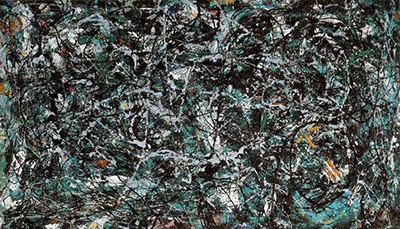Full Fathom Five (1947) by Jackson Pollock (1912-1956), is an example of an experimental piece of work that has a two-dimensional and three-dimensional appeal to the viewer.
Full Fathom Five is a metaphor for the human mind: whilst it appears to shine and glitter in the light, beneath the surface, the assortment and randomness of the composition show the anxious and dark mind of humanity.
The title is a direct quotes from William Shakespeare’s play, The Tempest: "Full fathom five thy father lies / Of his bones are coral made / Those are pearls that were his eyes.". The churning colours in the painting represent the shipwreck, as described by Ariel in The Tempest.
The ‘accidental nature’ of the 'painting' process meant that Pollock combined layers of paint with contents of his trouser-pocket paraphernalia to create a unique, optical pattern. Embedding everyday materials and textures into the painting provides a three-dimensional element.
Pollock embedded these textural agents (matches, keys, screws, paint-tube tops, nails, buttons, a torn cigarette and coins) into the surface of Full Fathom Five and covered them with layers and layers of paint, so they appear almost invisible in reproductions of the painting.
However, when your fingertips touch the surface, or the light shines onto surface, the undulations and textures amplify the potential and simplicity of the image.
It is one of Pollock's first "drip" paintings, and demonstrates his ability to creatively adapt and refine his artistic techniques. The top layers consist of house paint poured in black and silver lines over the chaotic and ununiformed labyrinth beneath.
Pollock used a palette knife and brush to apply most of the paint’s crust, contrasting the weaving paint drips with angular lines. The paint envelopes the assortment of everyday detritus that is obscured from view but has been randomly dropped across (and stuck into) the canvas.
With dense, multiple layers and colours of paint crisscrossing the canvas in a random design, the painting creates an agitated sense of chaos.




